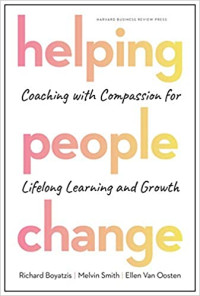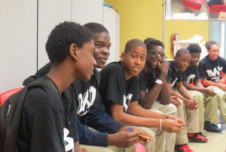Recently, an employee at a major Ohio company lost his mother to coronavirus. Under normal circumstances, his colleagues would have offered expressions of support and sympathy in person. They would have attended a funeral or memorial service. They would have made a meal for his family. But, since the state was under stay-at-home orders, none of that was possible.

At first, the team looked to their manager for guidance about what to do. But the manager hadn’t faced a situation like this and didn’t really know. So, he reflected the question back to his team: “What do you think we can do to help?”
The team suggested a Zoom call that evening. A 30-minute planning call turned into 90 minutes of sharing their feelings and brainstorming how to express their sympathy, but also checking in on one another and even finding some humor in each other’s stories of being cooped up at home. By starting a dialogue and listening to their suggestions, the manager helped individuals to cope with their grief while enabling them to collaborate on a solution. The experience opened up the team to new ideas and ways of adapting to highly confusing and uncertain times.
Whether you are a manager, teacher, physician, nurse, counselor, or cleric, you are a leader in your organization and community. In times of uncertainty and distress, it’s often hard to know how to best help others, much less motivate them to continue performing, learning, and growing. This can be especially difficult in the midst of the COVID-19 pandemic, which is changing how you work, how you learn, how you play, and how you communicate.
Many of your colleagues, clients, patients, and students are experiencing financial stress, uncertainty, and fear. It’s understandable for you to feel utterly helpless—and it’s natural to cling to the status quo, urging people to stick to deadlines, assigned tasks, and as-normal-as-possible routines. But that would be a mistake.
As we explain in our new book Helping People Change, the best leaders and coaches seek to connect with and understand others. They prioritize their team’s needs and create an environment of trust and support. They attend to building relationships, not just completing tasks. They motivate others to adapt, develop, persevere, and perform, even in the most trying of times, through a process we refer to as coaching with compassion.
Coaching with compassion
In the face of uncertainty, it is tempting to slip into taskmaster mode and resort to simply telling others what to do in order to fix a problem or improve a situation. We call that coaching for compliance because the aim is compliance to some external standard of how a person should behave or what they should accomplish. That can sometimes work when the context is predictable and known and the goal is clearly and discretely defined, such as coaching a salesperson to achieve quarterly goals. But none of these characteristics apply to periods of volatility and distress.
Research suggests that coaching for compliance often leads to an outcome that is the opposite of what we desire. The individual can feel pressured or obligated, which activates a physiological state known as the “negative emotional attractor.” This state involves the body’s stress response system, which is essential for our fight-or-flight instinct, but will inhibit a person’s ability to actually learn, grow, and change. When the negative emotional attractor is triggered, a person is likely to become defensive and closed down emotionally, cognitively, and physiologically.
Coaching with compassion, on the other hand, involves helping others to uncover or discover their ideas, feelings, hopes, and dreams and then supporting them in their efforts to adapt and change. This approach emphasizes the needs of the individual or group, rather than the agenda of the leader, and prioritizes building a resonant relationship with others. A resonant relationship is one anchored in mutual trust, where the leader takes intentional steps to notice people’s efforts and express gratitude, as well as suspend judgment and deeply listen.
Connecting and coaching with compassion activates an alternate physiological state, known as the “positive emotional attractor.” When we create resonant relationships with others, positive emotions are unleashed and the person is likely to feel more confident, hopeful, and open to considering new ideas. This also creates a sense of renewal for both parties in the relationship, thus reducing the negative effects of stress.
In two of our brain imaging studies, we found that when people discussed their dream or personal vision with a coach for 30 minutes, it activated the brain networks that enable us to be open to new ideas and other people. In contrast, 30 minutes of discussing their current problems suppressed these networks. This effect explains why 25 to 35 year olds who receive coaching see a dramatic improvement in their emotional and social intelligence that lasts for years.
How to coach with compassion
We have more opportunities to lead and coach with compassion than we often realize, but it requires us to be intentional about being aware of ourselves and others and about cultivating empathy in our conversations and relationships. Quite simply, we need to remember to “REACH2”—to follow the six steps below as we strive to help others.
 This essay is adapted from Helping People Change: Coaching with Compassion for Lifelong Learning and Growth (Harvard Business Review Press, 2019, 256 pages).
This essay is adapted from Helping People Change: Coaching with Compassion for Lifelong Learning and Growth (Harvard Business Review Press, 2019, 256 pages).
R stands for resonance. Leaders need to reach out and connect in ways that are in sync and in tune with others’ thoughts, feelings, and experiences. The goal is to create a supportive, trusting, positive relationship in which you are focused on the other person over yourself.
In one organization, for example, a manager carved out 30-minute windows of time at the beginning of each workday and invited individuals on his team to join him virtually. He called it “coffee with Kevin.” His intention was to check in with each person without having a laundry list of tasks to cover. Once people slowly started to attend, Kevin was shocked at how much he didn’t know about the individuals on his team, and how much he enjoyed getting to know them better. This simple act enabled him to feel more connected to them in rewarding ways.
E reminds us to lead with empathy. We need to shift our concern from wanting to be understood to understanding others.
At one U.S. university, the campus closed abruptly and courses transitioned online as cases of COVID-19 accelerated. One professor received an email from a student asking for an extension on her final course paper, worth one-third of her grade. The student explained how she had returned to Spain to help her family, whose business was in trouble amid the pandemic, and she was now working 14-hour days and struggling to concentrate in school.
The professor had a choice—to urge the student to prioritize school, share her concerns, or just discuss the details of the assignment and avoid the other topics altogether. She put herself in the student’s shoes and imagined the stress of the situation. She knew the assignment required focus and critical thinking, which would be difficult to muster even in normal conditions. She ultimately agreed to a one-week extension, which in turn lifted a heavy burden from the student’s shoulders and enabled her to finish the semester on a positive note.
A is about being aware of yourself and others. Before you can help others, you need to be clear on your mindset and emotions and their impact on the people and the environment around you. Emotions are contagious; so when you lead with joy, hope, humor, and love, others feel that. And when you lead with fear, anger, disappointment, and disgust, that rubs off on others, too.
One way to improve your self-awareness is to practice deep breathing exercises. Becoming aware of your breath can help you to calm your mind and your body and enable you to tune into yourself. Practicing deep breathing also helps you to reset your mind and body so that you can respond appropriately. For you, that might be before an important meeting that is likely to get heated or after reading an email from a colleague with unsolicited, constructive criticism on your work—or, really, any time you feel your neck stiffen and your heart start racing.
C represents connecting with compassion. When we act from a place of compassion, we focus on the needs of others and respond in meaningful ways. Coaching others with compassion emphasizes caring, warmth, and tenderness to help another person in their professional development. We often have a front-row seat to expressions of emotion in others, running the gamut from joy to sadness to anger. When you demonstrate compassion in helping roles, you listen and respond to the emotions beyond the person’s words.
For example, in a recent session, a coachee in our network welled up with tears in response to a question posed by her coach. The coach paused, allowed her to catch her breath, and then said, “I can see that struck a chord. Did you want to talk more about what’s behind the tears?” In situations like this, our tendency might be to ignore the person’s expression of emotion and continue with the discussion as if nothing happened. The problem is that you dismiss the person in the process and send the message that you don’t care about their feelings, which in turn may cause them to close down further.
H is about spreading hope. You unleash positive emotions and uplift others when you help them to envision a brighter and better future. In the face of uncertainty, the tendency can be to succumb to worry, fear, and anxiety. Intentionally spreading hope is about acknowledging the difficulty and also the possibilities. In coaching conversations, that can take shape by reminding the other person of their strengths as well as your belief in their ability to get through the period of uncertainty. You can help others tap into hope by asking them what is possible now that wasn’t as likely before.
H also refers to the power of humor. Stress shuts us down to new ideas and experiences. It also makes us less likely to find things funny or amusing or be playful. By keeping things light, you remind others to keep smiling. Having a sense of humor and promoting laughter in the workplace has been shown to reduce stress and increase satisfaction, productivity, and performance.
Consider, for example, a team who made a sizable error that caused them to significantly overstate their department’s quarterly forecast in the organization’s end-of-year projections. When they sat down with their manager to disclose the error, you could feel the tension in the air as they awaited what would surely be an angry outburst. Instead, the manager paused for a moment, then smiled and said, “I guess I need to call the car dealership and cancel my order for that Porsche.”
Everyone laughed, and immediately you could feel the tension in the room dissipate. They were in a much better place mentally and emotionally to have a productive discussion about how they could best address the issue and prevent any future errors. Using humor didn’t make the problem go away, but it did signal to everyone that it wasn’t the end of the world and that together they could come up with a creative solution.
The most powerful way to ameliorate the stress and uncertainty we are feeling is to reach out and help others. This can be in small doses by helping them laugh, helping them figure out how they want to act, or stimulating in them a moment of discovery. In highly uncertain times, instead of quickly jumping into advice-giving mode or falling back on the often-dysfunctional approach of telling people what to do, we have a rare opportunity. By reaching out and connecting with compassion, we encourage others to be open, and to learn, change, and develop in meaningful ways during this time of crisis.










Comments